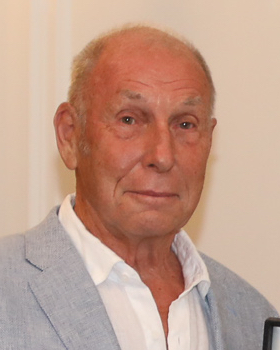
Riverton, officially Riverton / Aparima, is a small New Zealand town 30 kilometres (19 mi) west of Invercargill, on the south-eastern shorelines of the Jacobs River Estuary. The estuary is formed by the Aparima and Pourakino rivers, leading through a narrow outflow channel into Foveaux Strait. Accessible via State Highway 99 on the Southern Scenic Route, the main part of the town is on flat land and the northern end of Oreti Beach. South Riverton is built on the hills between the eastern shore of the estuary and Taramea Bay.
Events from the year 1937 in art.

Sir Grahame Charles Sydney is a New Zealand visual artist, based in the South Island region of Central Otago. Since beginning his professional art life in 1974 he has worked as a painter, printmaker, photographer and writer.
Graham Percy was a New Zealand-born artist, designer and illustrator. His work was the subject of The Imaginative Life and Times of Graham Percy, a major posthumous exhibition of his work which was shown at galleries throughout New Zealand including City Gallery Wellington, Gus Fisher Gallery Auckland, Sarjeant Gallery Whanganui, the Rotorua Museum and the Southland Museum and Art Gallery, Invercargill.

Queens Park is a park in Invercargill, New Zealand, and was part of the original plan when Invercargill was founded in 1856. The park is 200 acres (0.81 km2) in extent. It is just north of the city centre, bounded by Queens Drive to the east, Kelvin Street to the west, Gala Street to the south and Herbert Street to the north. The Gala Street entrance features the Feldwick Gates, built in 1924 and named after John Feldwick, brother of MP Henry Feldwick.

John Z. Robinson is a New Zealand painter, printmaker, and jeweller. He has lived in Dunedin, New Zealand since 1978.
Mark Adams is one of New Zealand's most distinguished photographers.
The William Hodges Fellowship residency programme is the successor to the Southland Art Foundation Artist in Residence.
Irene Ferguson is an artist best known for her portrait paintings. Ferguson was awarded the New Zealand Portraiture Award in 2008.

Southland is New Zealand's southernmost region. It consists mainly of the southwestern portion of the South Island and Stewart Island/Rakiura. It includes Southland District, Gore District and the city of Invercargill. Murihiku Southland is bordered by the culturally similar Otago to the north and east, and the West Coast in the extreme northwest. The region covers over 3.1 million hectares and spans 3,613 km of coast. As of June 2023, Southland has a population of 103,900, making it the eleventh-most-populous New Zealand region, and the second-most sparsely populated.

Caley J. Hall is classified as a listed New Zealand investment artist in Invercargill and Queenstown, New Zealand. Hall specializes in oil painting, and is well known for his Fiordland landscapes and expressionist abstracts. A largely self-taught artist, he has learned techniques and takes inspiration from other New Zealand artists, including renowned Queenstown-based painter Tim Wilson, Canterbury wilderness artist Nathanael Provis and Central Otago-based painter Peter Beadle. He exhibited his large abstracts at the Peppers Bluewater Resort in Tekapo in 2012.
Peter Chanel Peryer was a New Zealand photographer. In 2000, he was one of the five inaugural laureates of the Arts Foundation of New Zealand.
Molly Morell Macalister was a New Zealand artist. Known for painting, woodcarving, and sculpture, her work is held in the collection of the Museum of New Zealand Te Papa Tongarewa.
Marilynn Lois Webb was a New Zealand artist, noted for her contributions to Māori art and her work as an educator. She was best known for her work in printmaking and pastels, and her works are held in art collections in New Zealand, the United States, and Norway. She lectured at the Dunedin School of Art, and was made an emeritus principal lecturer in 2004.

Sam Foley is a contemporary New Zealand landscape painter.
Adrienne Martyn is a New Zealand art photographer. Her work has been collected by numerous art galleries, museums and libraries in New Zealand including the Museum of New Zealand Te Papa Tongarewa, the Dowse Art Museum, the Auckland Art Gallery, the Christchurch Art Gallery and the Hocken Library.
Heather Straka is a New Zealand artist, based in Auckland, who primarily works with the media of painting and photography. Straka is well known as a painter that utilises a lot of detail. She often depicts cultures that are not her own, which has caused controversy at times. Her work engages with themes of economic and social upheaval in interwar China, the role of women in Arabic society and Māori in relation to colonisation in New Zealand. Eventually, the figure became important in Straka's practice and she began to use photographs as the starting point for some of her works and "Increasingly too the body feminine has become her milieu".

Dorothy Catherine Wentworth Jenkin was a New Zealand watercolorist, botanical illustrator and printmaker. She was a founding member of the Invercargill Art Society and participated in campaigning for a public art gallery in Invercargill. She was involved in ensuring the acquisition of Anderson Park and the establishment of the Invercargill Art Gallery at that location. Many of her works are held at the Rakiura Museum and have been reproduced as prints and postcards.

Jonathan Robert White was a New Zealand landscape artist. Largely self-taught, his work is recognised both in New Zealand and internationally, and is held in many public and private collections across the world. White painted professionally for over 50 years and held many solo and joint exhibitions; he died two weeks before his final exhibition was held in Invercargill.








